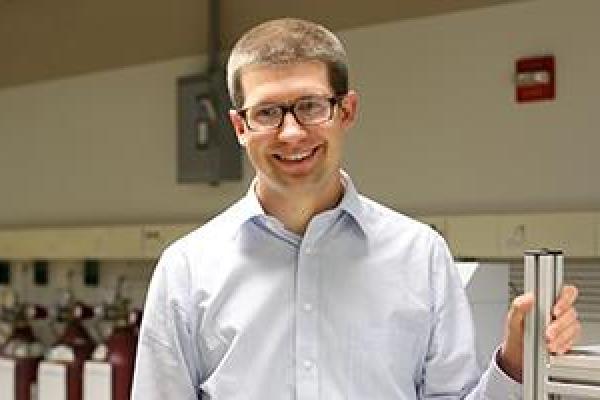Chemist Receives DOE Early Career Award: Ohio State’s First

Robert Baker, assistant professor, chemistry and biochemistry; is one of 50 outstanding young researchers from around the country — and Ohio State’s first — receiving 2015 Department of Energy Early Career Research Awards. Of those selected, 34 are university researchers, 16 conduct research at national DOE labs.
The program, initiated in 2011, supports the development of individual research programs of outstanding scientists early in their careers, stimulating research in disciplines supported by DOE’s Office of Sciences.
Baker’s proposal, “Probing Ion Solvation and Charge Transfer at Electrochemical Interfaces Using Nonlinear Soft X Ray Spectroscopy,” will be funded for five years at $150,000 per year.
This grant will accelerate his research to explore the use of nanomaterials and solid-state electronic devices for chemical energy conversion and highly selective catalysis.
A major, unexplored frontier of materials chemistry is the critical role of surfaces and interfaces in nano-scale systems, particularly the properties of surfaces and interfaces that control charge transfer in actual energy conversion systems. These systems include solar cells, fuel cells, batteries, photocatalysts and electrocatalysts.
Because charge transfer across the interface between two materials dominates the energy conversion efficiency of all these devices, finding creative experimental ways to visualize interfacial charge transfer is necessary to learn how to design new materials and catalysts for high efficiency applications.
This work, which necessitates being able to “see” events playing out at the molecular level, requires access to a new type of light source, one that cannot be ordered from a scientific equipment catalogue.
“We will be using a bench-top, soft x-ray laser,” Baker said. “There are very few out there, so essentially we will be building it ourselves, but it will allow us get a better look at interfaces, which are always different from the bulk of material and more difficult to understand.
“It will be a big leap to be able to see molecular details at the interface — the internal surface of layers that are buried. These details of charge transfer are critical steps for energy storage and conversion in batteries — and, they hold the key for making current technologies viable.”
What Baker really wants to see is that step when ions in solution go into the electrode because this is where the action is. This process involves bias-induced stripping of the solvent shell at the electrode surface, which is a kinetic barrier to energy storage. The goal to see how molecules behave at the interface will allow better understanding of how to control that step and will lead to improved devices.
“To see something that’s never been seen before is exciting. And to do experiments that have never been done before — to push experimental frontiers forward and to bring components of different fields together to solve problems that one person or discipline alone cannot — is even more exciting. To tackle big energy challenges, collaboration is absolutely necessary.
“I chose to come to Ohio State,” Baker said, ”because there is such energy here and so much collaborative activity, both of which are really important in making an impact.”
Baker, who has been at Ohio State not quite a year has already made an impact. This is not his first significant research award; in January, 2015, he received an Air Force Office of Scientific Research 2015 Young Investigator Award.
Baker received his PhD from the University of California, Berkeley, in 2012 where his dissertation research focused on electronic activation of surface chemical reactions at the metal-support interface. From 2012 to 2014, he performed postdoctoral research with Stephen Leone studying ultrafast electron dynamics and interfacial charge transfer in metal oxides using transient x-ray absorption spectroscopy. He has been an assistant professor at The Ohio State University since July 2014.
—Sandi Rutkowski
